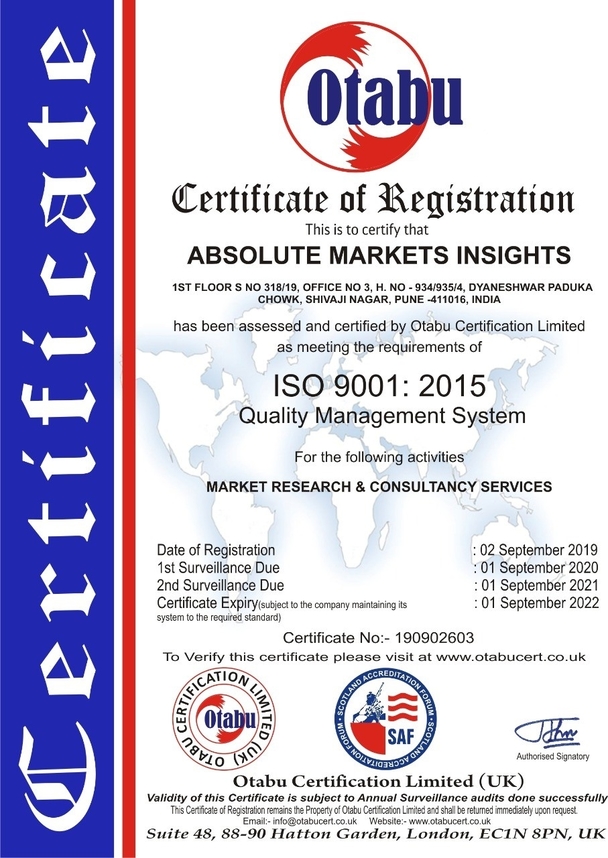
Global Passport Reader Market is anticipated to Grow at a CAGR of 10.5% by 2027 Owing to the Imminent Security Threats from Migrant Smuggling, says Absolute Market Insights
Global rise in emigration is increasing the workload of immigration officers resulting in automation of passport verification process. Various geopolitical reasons including war in Syria and Iraq resulted in migration of people to greener pastures. Globally, to restrict illegal entry of massive migrant population automatic passport verification machines such as passport reader are increasingly adopted by countries which is resulting in market growth.
Passport readers are document identification devices utilizing technologies such as optical character recognition (OCR), radio-frequency identification (RFID), barcode among others for decoding the information on passports. Passport readers automate the process of manually checking and filling the information in the system. Presently social and environmental unrest across the world has resulted in increase in the number of migrants. For instance, United Nations (UN) states that the globally international migrants have increased at a faster rate than the world population to account for 3.7% of total world population in 2017. In addition, rise in migrant smuggling activities around the globe have posed imminent threat to countries, mandating them to protect themselves against these illegal activities which is giving rise to social disturbances and increasing the demand for passport reader. For instance, in 2018 a report by United Nations Office on Drugs and Crime (UNODC) states that about 2.5 million migrants were smuggled worldwide in 2016. Rise in smuggling of migrants has risen the number of passport forgeries. For instance, in 2016 as per BBC more than 1000 fake passports have been seized at UK borders. Manual inspection of passports at security check points pose limitations which have pushed the growth of passport reader market worldwide.
The growth in implementation of passport readers at border crossings, airports and harbors is estimated to be driven by adoption of advanced security check solutions by governments of multiple countries to overcome the threats from passport forgeries and other fraudulent practices promoting migrant smuggling. For instance, European Union has initiated a project, ‘Smart Borders’ in 2013 which aims to streamline the external border management. The European Commission is proposing Smart Border packages including Kiosk systems which features biometric scanners, passport readers and other technologies for effective border management. Also as per a recent news article published by The Washington Post, Kevin McAleenan, an officer from United States Department of Homeland Security (DHS), during his visit to a humanitarian camp in Panama, proposed to provide passport readers to ease the border check process. Owing to these factors, harbors, airports and border control applications account for more than half of the global passport reader market over the forecast period.
The detailed research study provides qualitative and quantitative analysis of the global passport reader market. The passport reader market has been analyzed from demand as well as supply side. The demand side analysis covers market revenue across regions and further across all the major countries. The supply side analysis covers the major market players and their regional and global presence and strategies. The geographical analysis done emphasizes on each of the major countries across North America, Europe, Asia Pacific, Middle East & Africa and Latin America.
Purchase the complete report titled “Passport Reader Market - Global Insights, Growth, Size, Comparative Analysis, Trends and Forecast, 2015-2027” at
https://www.absolutemarketsinsights.com/reports/Global-Passport-Reader-Market-2019-2027-425
Global Passport Reader Market Share in 2018, By Region
Key Findings of the Report:
- In terms of the revenue, the global passport reader market is expected to grow at a CAGR of more than 10.5% by 2027 owing to rise in number of migrant population which pose a security threat to a nation’s national interest. .
- On the basis of technology, Radio-frequency Identification (RFID) segment is estimated to have the largest market share in global passport reader market owing to increasing adoption of epassports which has a RFID chip containing biometric information of the passport holder.
- Asia Pacific region is estimated to grow at the highest rate of 12.2% owing to the industrialization in the region leading to increased number of business travelers in the region which mandates use of passport readers to reduce the queues at check points.
- Some of the players operating in the global passport reader market includes ARH Inc., Bejing Wintone Science & Technology Co. Ltd., Bundesdruckerei GmbH, Gemalto NV, IDEMIA, Regula Ltd., Veridos GmbH amongst others.
Global Passport Reader Market:
- By Offerings
- Stand-alone
- Integrated
- By Technology
- Optical Character Recognition (OCR)
- Radio-frequency Identification (RFID)
- Barcode
- Others
- By Type
- Full-page Reader
- Half-page Reader
- Swipe Reader
- Others
- By Document Format
- ID-1 Format
- ID-2 Format
- ID-3 Format
- Other
- By End Users
- Border Control Applications & Social Security
- Police
- Passport Issuing & VISA application
- Government
- Rental Car Companies
- Hotels & Casinos
- Corporates (Employee Vetting)
- Harbors and Airports
- Banks
- Train/ Bus Terminals
- Immigration Services
- Travel Agencies
- Others
- By Region
- North America
- U.S.
- Canada
- Mexico
- Rest of North America
- Europe
- France
- The UK
- Spain
- Germany
- Italy
- Nordic Countries
- Denmark
- Finland
- Iceland
- Sweden
- Norway
- Benelux Union
- Belgium
- The Netherlands
- Luxembourg
- Rest of Europe
- Asia Pacific
- China
- Japan
- India
- New Zealand
- Australia
- South Korea
- Southeast Asia
- Indonesia
- Thailand
- Malaysia
- Singapore
- Rest of Southeast Asia
- Rest of Asia Pacific
- Middle East & Africa
- Saudi Arabia
- UAE
- Egypt
- Kuwait
- South Africa
- Rest of Middle East & Africa
- Latin America
- Brazil
- Argentina
- Rest of Latin America
- North America

